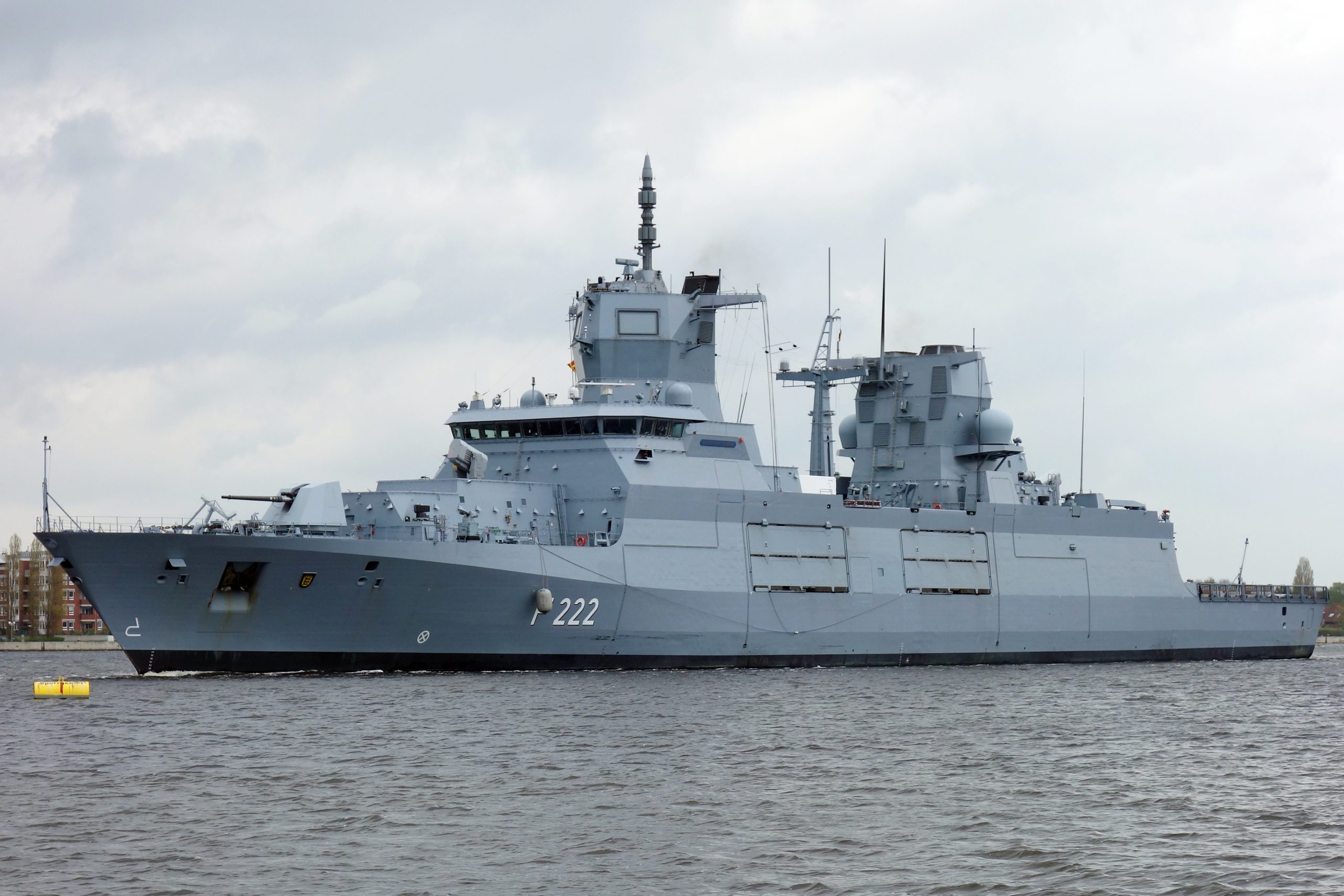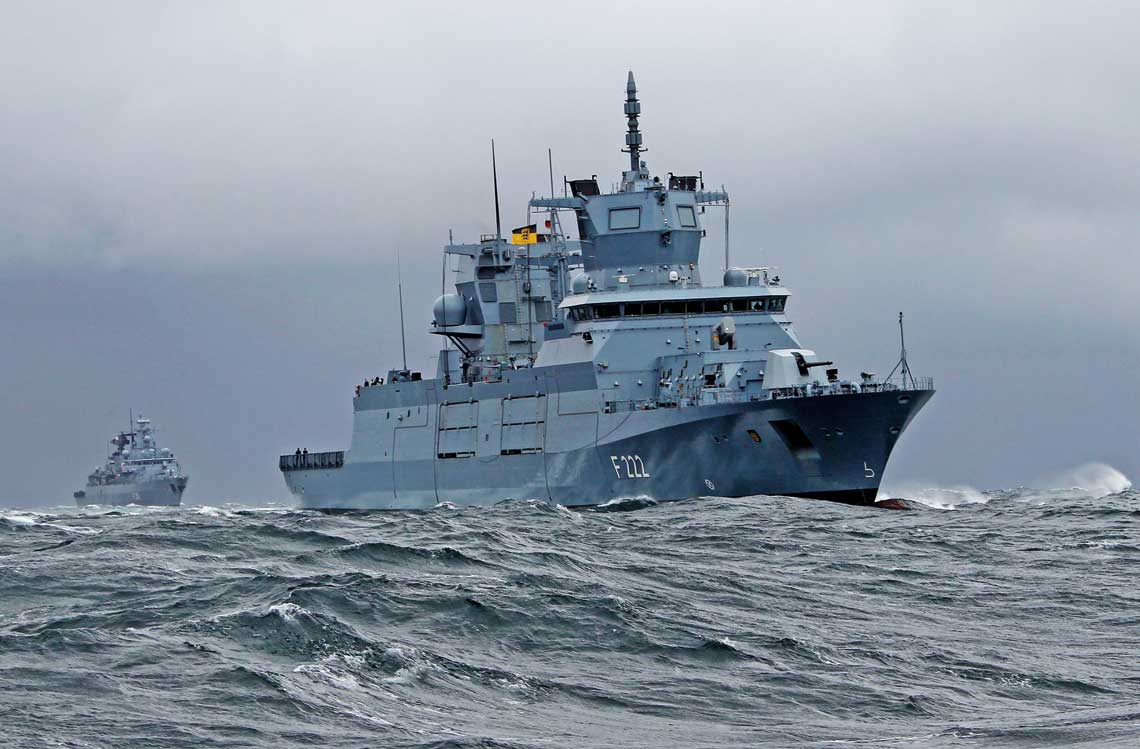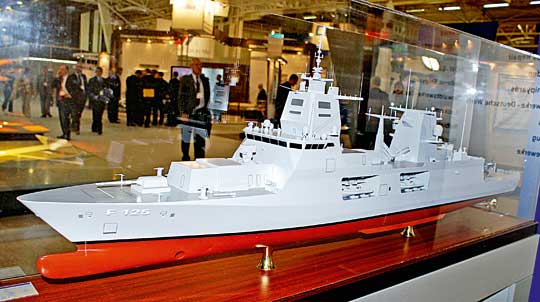
Frigate F125

The prototype of the frigate Baden-Württemberg at sea during one of the stages of sea trials.
On June 17 this year, the flag-raising ceremony for Baden-Württemberg, the prototype of the F125 frigate, took place at the naval base in Wilhelmshaven. Thus, another important stage of one of the most prestigious and controversial Deutsche Marine programs has come to an end.
The end of the Cold War left its mark on changes in the naval structures of most European countries, including Deutsche Marine. For almost half a century, this formation was focused on combat operations in cooperation with other NATO countries with warships of the Warsaw Pact countries in the Baltic Sea, with particular emphasis on its western part and approaches to the Danish Straits, as well as on the defense of its own coast. The most serious reforms in the entire Bundeswehr began to gain momentum in May 2003, when the Bundestag presented a document defining German defense policy for the coming years - the Verteidigungspolitische Richtlinien (VPR). This doctrine rejected the basic measures of local defense mentioned so far in favor of global, expeditionary tasks, the main purpose of which was to counteract and resolve crises in inflammatory regions of the world. Currently, Deutsche Marine has three main areas of operational interest: the Baltic and Mediterranean Seas and the Indian Ocean (mainly its western part).

Model F125 presented at Euronaval 2006 in Paris. The number of radar antennas has been increased to four, but there is still only one on the aft superstructure. MONARC is still on the nose.
To unknown waters
The first mention of the need to acquire ships adapted to the tasks arising from the changing political situation in the world appeared in Germany as early as 1997, but the work itself gained momentum only with the publication of the VPR. The F125 frigates, also called the Baden-Württemberg type after the name of the first unit of the series, make up the second - after the anti-aircraft F124 (Sachsen) - generation of German ships of this class, designed in the post-war period. Cold War period. Already at the research stage, it was assumed that they would be able to:
- conduct long-term operations far from the base, mainly of a stabilization and police nature, in areas with an unstable political situation;
- maintain dominance in coastal areas;
- support the operation of the allied forces, providing them with fire support and using the landed special forces;
- perform the tasks of command centers as part of national and coalition missions;
- provide humanitarian assistance in areas of natural disasters.
To meet these challenges, for the first time in Germany, an intensive use concept was adopted during the design phase. According to the initial assumptions (which remained unchanged throughout the entire period of design and construction), new ships should continuously perform their tasks for two years, being at sea up to 5000 hours a year. Such intensive operation of the units away from repair bases forced to increase the maintenance intervals of the most important components, including the drive system, up to 68 months. In the case of previously operated units, such as the F124 frigates, these parameters are nine months, 2500 hours and 17 months. In addition, the new frigates had to be distinguished by a high level of automation and, consequently, a crew reduced to the required minimum.
The first attempts to design a new frigate were made in the second half of 2005. They showed a ship 139,4 m long and 18,1 m wide, similar to the F124 units nearing completion. From the very beginning, a characteristic feature of the F125 project was two separate island superstructures, which made it possible to separate electronic systems and control centers, increasing their redundancy (assuming the loss of some of their capabilities in the event of failure or damage). When considering the choice of drive configuration, the engineers were guided by the issue of reliability and resistance to damage, as well as the already mentioned need for extended service life. In the end, a hybrid CODLAG system (combined diesel-electric and gas turbine) was chosen.
In connection with the assignment of tasks to new units in the Primorsky theater of operations, it was necessary to install appropriate weapons capable of providing fire support. Variants of large-caliber cannon artillery (the Germans used 76 mm in recent years) or rocket artillery were considered. Initially, the use of very unusual solutions was considered. The first was the MONARC (Modular Naval Artillery Concept) artillery system, which assumed the use of a 155-mm PzH 2000 self-propelled howitzer turret for naval purposes. Tests were carried out on two F124 frigates: Hamburg (F 220) in 2002 and Hessen (F 221) in August 2005. In the first case, a modified PzH 76 turret was installed on the 2000 mm gun, which made it possible to test the possibility of physical integration of the system on the ship. On the other hand, a whole cannon howitzer, attached to the helipad, hit Hesse. Firing was carried out at sea and ground targets, as well as checking the interaction with the ship's fire control system. The second weapon system with land roots was to be the M270 MLRS multiply charged rocket launcher.
These undeniably avant-garde ideas were abandoned in early 2007, the main reason being the high cost of adapting them to a much more complex marine environment. It would be necessary to take into account corrosion resistance, dampening the recoil force of large-caliber guns, and finally, the development of new ammunition.
Construction with obstacles
One of Deutsche Marine's most prestigious programs has caused a lot of controversy from the very beginning, even at the ministerial level. Already on June 21, 2007, the Federal Audit Chamber (Bundesrechnungshof - BRH, equivalent to the Supreme Audit Office) issued the first, but not the last, negative assessment of the program, warning both the federal government (Bundesregierung) and the Bundestag. Finance Committee (Haushaltsausschusses) against violations. In its report, the Tribunal showed, in particular, an imperfect way of drawing up a contract for the construction of ships, which was extremely beneficial for the manufacturer, since it involved the repayment of as much as 81% of the total debt before the delivery of the prototype. Nevertheless, the Finance Committee decided to approve the plan. Five days later, the ARGE F125 (Arbeitsgemeinschaft Fregatte 125) consortium of thyssenkrupp Marine Systems AG (tkMS, leader) and Br. Lürssen Werft has signed a contract with the Federal Office for Defense Technology and Procurement BwB (Bundesamt für Wehrtechnik und Beschaffung) for the design and construction of four F125 expeditionary frigates. The value of the contract at the time of its signing was almost 2,6 billion euros, which gave a unit value of 650 million euros.
According to the document signed in June 2007, the ARGE F125 was supposed to hand over the prototype of the unit by the end of 2014. However, as it turned out later, this deadline could not be met, since the cutting of sheets for the construction of the future Baden-Württemberg was laid only on May 9, 2011 ., and the first block (dimensions 23,0 × 18,0 × 7,0 m and weight approx. 300 tons), constituting a symbolic keel, was laid almost six months later - on November 2.
At the beginning of 2009, the project was revised, changing the internal structure of the hull, increasing, among other things, the area of equipment and weapons depots for airborne helicopters. All the amendments made at that time increased the displacement and length of the ship, thus accepting the final values. This revision forced the ARGE F125 to renegotiate the terms of the contract. BwB's decision gave the consortium an additional 12 months, thus extending the program until December 2018.
Since the leading role in ARGE F125 is played by the tkMS holding (80% of the shares), it was he who had to decide on the choice of subcontractors involved in the construction of new blocks. The shipyard whose task it was to prefabricate the middle and aft sections, combine the hull blocks, their final equipment, system integration and subsequent testing was the Hamburg-based Blohm + Voss, then owned by tkMS (owned by Lürssen since 2011). On the other hand, the Lürssen shipyard in Vegesack near Bremen was responsible for the production and initial outfitting of the 62 m long bow blocks, including the bow superstructure. Part of the hull work (sections of the bow block, including the pears of the first pair of ships) was commissioned by the Peenewerft plant in Wolgast, then owned by Hegemann-Gruppe, then P + S Werften, but since 2010 Lürssen. Ultimately, it was this shipyard that produced complete bow blocks for the third and fourth frigates.